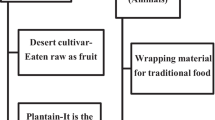Abstract
Bamboo shoots being low in fat, high in dietary fiber and rich in mineral content, like an ideal vegetable have been used traditionally. Besides nutrients, bamboo shoots also contain lethal concentration of the anti-nutrient (cyanogen) that need to be removed before human consumption. Therefore an attempt has been made to find out the best processing method for confiscation of cyanogens. B. bambos, B. tulda, D. strictus and D.asper were selected for the study. Fresh and processed bamboo shoots were analyzed for their various nutritional and anti-nutritional contents. Carbohydrate content in fresh shoots of studied species ranged from 2.39%–3.6%, proteins from 1.65%–2.08%, phenols from 0.36%–0.63%, cyanogens from 0.011%–0.018%, minerals did not vary significantly among the species except potassium which ranged from 0.32%–0.52%. The shoots were processed by boiling in water and different concentrations of NaCl (1%, 5% and 10%) for different intervals (10, 15, 20 and 25 min) to achieve maximum removal of cyanogens with minimum loss of nutrients. Boiling shoots in 5% NaCl for 15 min was found to be the best method for B. bamboos, 10 min boiling in 1% NaCl for B. tulda, 15 min boiling in 1% NaCl for D. strictus and 10 min boiling in 5% NaCl for D. asper. These processing methods will be very useful in utilization of bamboo shoots as these are very simple and can be used by the local inhabitants and shoot processing industries.
Similar content being viewed by others
References
Bhargava A, Kumbhare V, Srivastava A, Sahai A (1996) Bamboo parts and seeds for additional source of nutrition. J Food Sci Technol 33(2):145–146
Bhatt BP, Singh K, Singh A (2005) Nutritional value of some commercial edible bamboo species of North Eastern Himalayan Region, India. J Bamboo Rattan 4(2):111–124
Choudhury D, Sahu JK, Sharma GD (2011) Value addition to bamboo shoots: a review. J Food Sci Technol. doi:10.1007/s13197-011-0379-z
EFSA (2004) Opinion of the scientific panel on food additives flavourings, processing aids and materials in contact with food (AFC) on hydrocyanic acids in flavourings and other food ingredients with flavouring properties. Question no. EFSA-Q-2003-0145. EFSA J 105:1–28
ERG (Engineering Resource Group) (2003) Report on process, market & business opportunity report on edible bamboo shoot prepared by: Engineering Resources Group, Bangalore in association with CPF, FRESH and Delphi, pp 4–7
Ferreira VLP, Yotsuyanagi K, Carvalho CRL (1995) Elimination of cyanogenic compounds from bamboo shoots Dendrocalamus giganteus Munro. Trop Sci 35:342–346
FSA Food Standards Australia (2004) A human health risk assessment technical report series No. 28. Cyanogenic glycosides in Cassava and Bamboo shoots, New Zealand, pp 7–12
Fu MY, Ma NX, Qiu FG (1987) Bamboo production and scientific research in Thailand. Chin J Bamb Res 6(1):54–61
Galeotti F, Barile E, Curir P, Dolci M, Lanzotti V (2008) Flavonoids from carnation (Dianthus caryophyllus) and their antifungal activity. Phytochem Lett 1:44–48
Hedge JE, Hofreiter BT (1962) In: Whistler RL, Be Miller JN (eds) Carbohydrate chemistry. Academic, New York
Hogg PG, Ahlgren HL (1942) A rapid method for determining hydrocyanic acid content of single plants of sudan grass. J Am Soc Agron 34:199–200
Jacobs MB (1999) The chemical analysis of foods and food products. CBS Publishers and Distributors, New Delhi
Jaiwunglok P, Tia S, Yoovidhya T (2010) Effectes of temperature and pH on taxiphyllin degradation in bamboo shoots. In: Food Innovation Asia Conference, Indigenous Food Research and Development to Global Market, BITEC Bangkok, Thailand, June 17–18
Judprasong K, Charoenkiatkul S, Sungpuag P, Vasanachitt K, Nakjamanong Y (2006) Total and soluble oxalate contents in Thai vegetables, cereal grains and legume seeds and their changes after cooking. J Food Comp Anal 19(4):340–347
Kumbhare V, Bhargava A (2007) Effect of processing on nutritional value of central Indian Bamboo shoots—part I. J Food Sci Technol 44(1):29–31
Lowry OH, Rosebrough NJ, Farr AL, Randall RJ (1951) Protein measurement with folin phenol reagent. J Biol Chem 193:265
Mattile P, Hellstorm J (2007) Phenolic acids in potatoes, vegetables and some of their products. J Food Comp Anal 20:152–160
McDonald S, Prenzler PD, Autolovich M, Robards K (2001) Phenolic content and antioxidant activity of olive extracts. Food Chem 73:73–84
Nirmala C, Sharma ML, David E (2008) A comparative study of nutrient components of freshly harvested and canned bamboo shoots of D. giganteus Munro, bamboo science and culture. J Am Bamboo Soc 21(1):41–47
Oboh G, Ademosun AO (2010) Characterization of the antioxidant properties of phenolic extracts from citrus peels. J Food Sci Technol. doi:10.1007/s13197-010-0222-y
Raghu V, Platel K, Srinivasan K (2007) Comparison of ascorbic acid content of Emblica officinalis fruits determined by different analytical methods. J Food Comp Anal 20(6):529–533
Rana B, Awasthi P, Kumbhar BK (2010) Optimization of processing conditions for cyanide content reduction in fresh bamboo shoot during NaCl treatment by response surface methodology. J Food Sci Technol. doi:10.1007/s13197-011-0324-l
Rice-Evans C, Miller NJ, Pganga G (1997) Antioxidant properties of phenolic compounds. Trends Plant Sci 2:152–159
Scurlock JMO, Dayton DC, Hames B (2000) Bamboo: an overlooked biomass resource? Biomass Bioenergy 19(4):229–244
Seigler DS (1991) Cyanide and cyanogenic glycoside. In: Rosentahel GA, Berenbaum MR (eds) Herbivores: their interactions with secondary plant metabolites, vol I. The chemical participants. Academic, San Diego, pp 35–77
Tiwari DN (1992) A monograph on bamboo. International Book Distributors, Dehradun
Tripathi YC (1998) Food and nutrition potential of bamboo. MFP News 8(1):10–11
Vinning G (1995) Market compendium of Asian vegetables RIRDC Research Paper No. 95/12. Canberra, Rural Industries Research and Development Corporation 386
Wongsakpairod T (2000) Bamboo shoot drying using superheated steam. MEng Thesis, King Mongkut’s University of Technology, Thonburi, Bangkok, Thailand
World Health Organization (1993) Toxicological evaluation of certain food additives and naturally occurring toxicants. Report of the 39th meeting of the joint FAO/WHO Experts Committee on Food Additives (JECFA). Food Additive Series 30, pp 299–337
Author information
Authors and Affiliations
Corresponding author
Rights and permissions
About this article
Cite this article
Pandey, A.K., Ojha, V. Precooking processing of bamboo shoots for removal of anti-nutrients. J Food Sci Technol 51, 43–50 (2014). https://doi.org/10.1007/s13197-011-0463-4
Revised:
Accepted:
Published:
Issue Date:
DOI: https://doi.org/10.1007/s13197-011-0463-4




